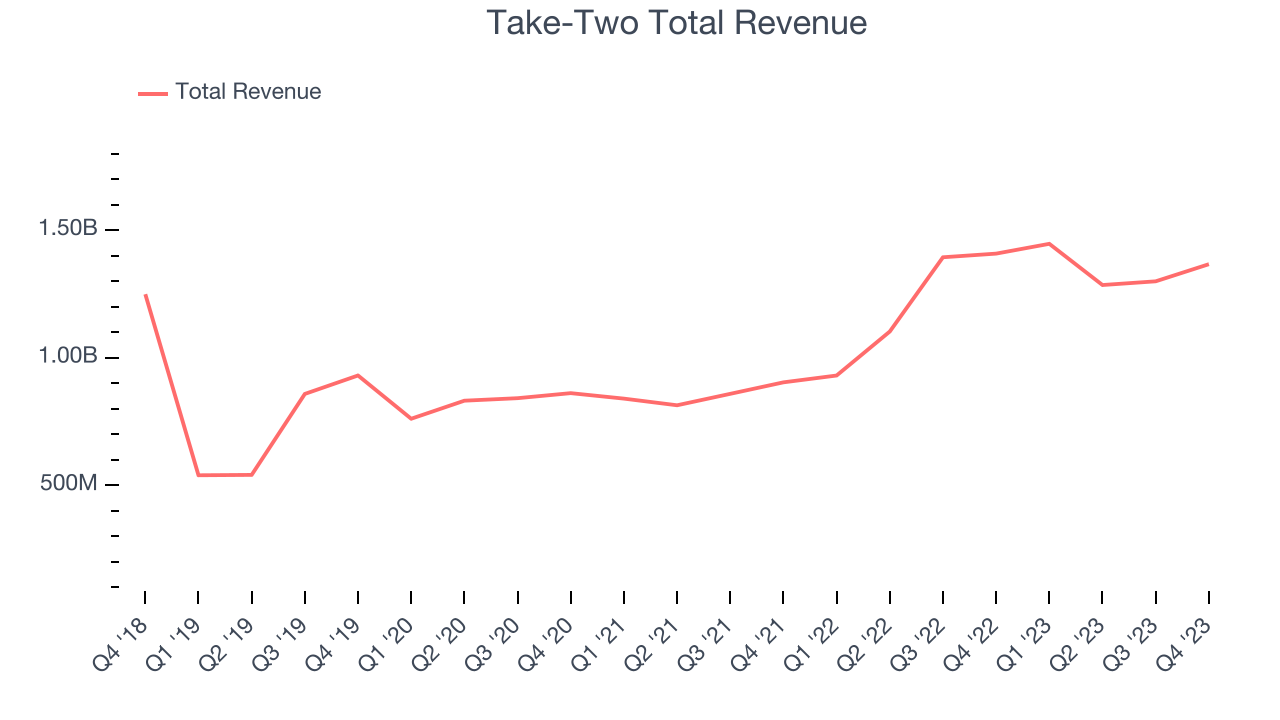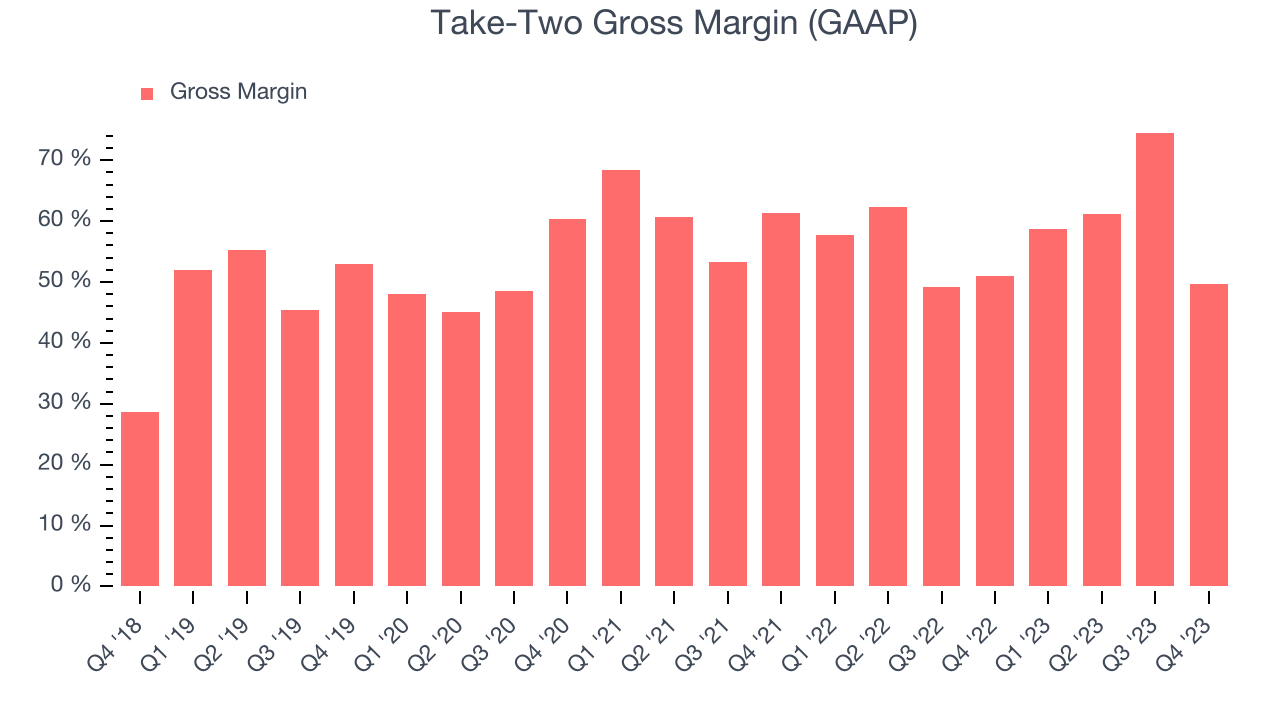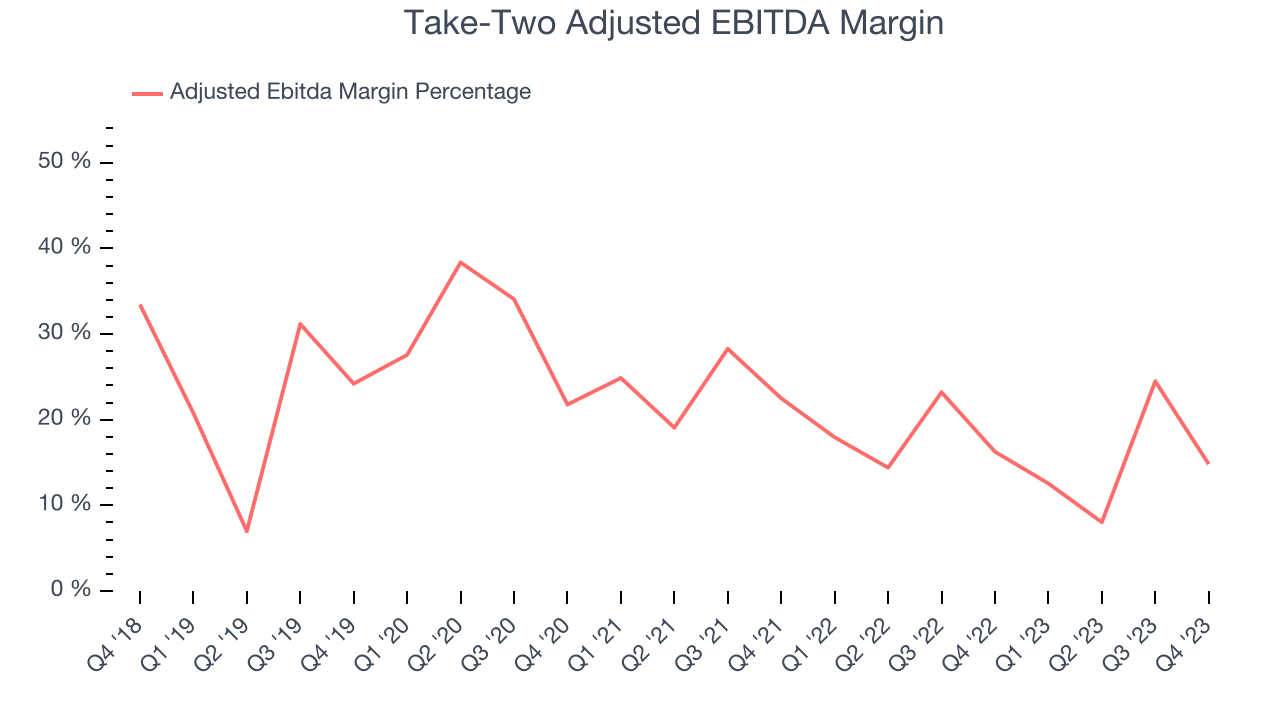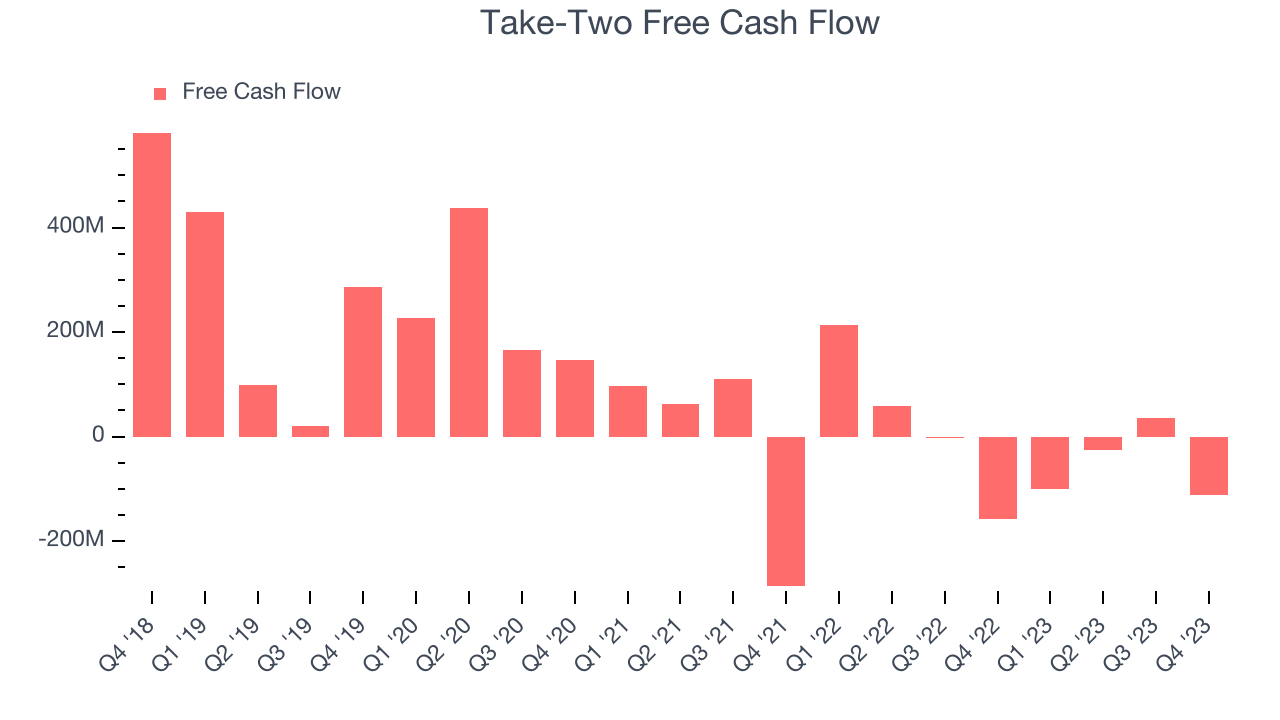Video game publisher Take Two (NASDAQ:TTWO) reported Q4 CY2023 results topping analysts' expectations, with revenue down 2.9% year on year to $1.37 billion. On the other hand, next quarter's revenue guidance of $1.35 billion was less impressive, coming in 11% below analysts' estimates. It made a non-GAAP profit of $0.71 per share, down from its profit of $0.86 per share in the same quarter last year.
Take-Two (TTWO) Q4 CY2023 Highlights:
- Revenue: $1.37 billion vs analyst estimates of $1.34 billion (2.2% beat)
- EPS (non-GAAP): $0.71 vs analyst expectations of $0.73 (2.3% miss)
- Revenue Guidance for Q1 CY2024 is $1.35 billion at the midpoint, below analyst estimates of $1.51 billion
- Gross Margin (GAAP): 49.6%, down from 51% in the same quarter last year
- Free Cash Flow was -$112.6 million, down from $36.4 million in the previous quarter
- Market Capitalization: $25.77 billion
Best known for its Grand Theft Auto and NBA 2K franchises, Take Two (NASDAQ:TTWO) is one of the world’s largest video game publishers.
Take Two develops video games for consoles, PCs, and mobile devices through its five main development studios: Rockstar Games, 2K, Private Division, Social Point, and Playdots. Take Two’s games range across multiple genres, from first person shooter, action, role-playing, strategy, sports and family/casual entertainment. It also employs a range of business models; Take Two sells full premium games along with free to play games with in game purchase, and subscription style content.
Unlike rivals EA and Activision, whose businesses are built on big releases of annualized content like Madden or Call of Duty, some of Take Two’s biggest franchises are released less frequently, with the company often taking years to develop new versions. Its biggest franchise, Grand Theft Auto’s last release was September 2013, while the October 2018 release of Red Dead Redemption II was in development for 8 years. Its NBA 2K series is its only major title with an annual release. The company also has a collection of mid-tier franchises that have more regular releases such as Bioshock, Borderlands, Mafia, and Sid Meier’s Civilization.
Video Gaming
Since videogames were invented in the 1970s, they have gradually taken more share of entertainment time. Ubiquitous mobile devices have powered a surge in “snackable” games that can be played on the go. Over time, games have developed more social engagement features where friends can play games together over the internet. The business models of games publishers have become less volatile due to digitization of distribution, in game monetization, and like Hollywood, an increasing dependence on surefire hit franchises. Covid driven lockdowns accelerated adoption and usage of videogames – a trend that has not slowed.
Take Two competes with other large video game companies such as Electronic Arts (NASDAQ:EA), Roblox (NYSE:RBLX), and Nintendo (TSE:7974).
Sales Growth
Take-Two's revenue growth over the last three years has been strong, averaging 20.2% annually. This quarter, Take-Two beat analysts' estimates but reported a year on year revenue decline of 2.9%.

Take-Two is expecting next quarter's revenue to decline 6.8% year on year to $1.35 billion, a reversal from the 55.5% year-on-year increase it recorded in the comparable quarter last year. Ahead of the earnings results, analysts were projecting sales to grow 21.4% over the next 12 months.
Pricing Power
A company's gross profit margin has a major impact on its ability to exert pricing power, develop new products, and invest in marketing. These factors may ultimately determine the winner in a competitive market, making it a critical metric to track for the long-term investor.
Take-Two's gross profit margin, which tells us how much money the company gets to keep after covering the base cost of its products and services, came in at 49.6% this quarter, down 1.3 percentage points year on year.
For gaming businesses like Take-Two, these aforementioned costs typically include royalties to sports leagues or celebrities featured in games, fees paid to Alphabet or Apple for games downloaded in their digital app stores, and data center and bandwidth expenses associated with delivering games over the internet. After paying for these expenses, Take-Two had $0.50 for every $1 in revenue to invest in marketing, talent, and the development of new products and services.

Take-Two's gross margins have been trending up over the last year, averaging 60.8%. These margins are around that of a typical consumer internet business, but Take-Two's rising margins may indicate improving pricing power or scale advantages over costs.
User Acquisition Efficiency
Consumer internet businesses like Take-Two grow from a combination of product virality, paid advertisement, and incentives (unlike enterprise software products, which are often sold by dedicated sales teams).
It's expensive for Take-Two to acquire new users as the company has spent 54.2% of its gross profit on sales and marketing expenses over the last year. This relative inefficiency indicates that Take-Two's product offering can be easily replicated and that it must continue investing to maintain its growth trajectory.
Profitability & Free Cash Flow
Investors frequently analyze operating income to understand a business's core profitability. Similar to operating income, adjusted EBITDA is the most common profitability metric for consumer internet companies because it removes various one-time or non-cash expenses, offering a more normalized view of a company's profit potential.
Take-Two's EBITDA was $202.4 million this quarter, translating into a 14.8% margin. The company has also shown above-average profitability for a consumer internet business over the last four quarters, with average EBITDA margins of 14.9%.

If you've followed StockStory for a while, you know that we emphasize free cash flow. Why, you ask? We believe that in the end, cash is king, and you can't use accounting profits to pay the bills. Take-Two burned through $112.6 million in Q4, increasing the cash burn by 28.7% year on year.

Take-Two has burned through $203.9 million of cash over the last 12 months, resulting in a negative 3.8% free cash flow margin. This below-average FCF margin stems from Take-Two's continuous need to reinvest in its business to penetrate the market.
Key Takeaways from Take-Two's Q4 Results
It was great to see Take-Two beat analysts' revenue expectations this quarter. On the other hand, its revenue growth regrettably slowed and its revenue guidance for next quarter missed Wall Street's estimates. Overall, the results could have been better. The stock is up 2.6% after reporting and currently trades at $154.93 per share.
Is Now The Time?
Take-Two may have had a bad quarter, but investors should also consider its valuation and business qualities when assessing the investment opportunity.
Although we have other favorites, we understand the arguments that Take-Two isn't a bad business. Its revenue growth has been solid over the last three years, and growth is expected to increase in the short term. And while its sales and marketing efficiency is subpar, the good news is its gross margins indicate a healthy starting point for the overall profitability of the business.
Take-Two's EV-to-EBITDA ratio based on the next 12 months is 17.9x. We don't really see a big opportunity in the stock at the moment, but in the end, beauty is in the eye of the beholder. If you like the company, it seems the price isn't completely unreasonable.
Wall Street analysts covering the company had a one-year price target of $176.42 per share right before these results (compared to the current share price of $154.93).
To get the best start with StockStory check out our most recent Stock picks, and then sign up to our earnings alerts by adding companies to your watchlist here. We typically have the quarterly earnings results analyzed within seconds of the data being released, and especially for the companies reporting pre-market, this often gives investors the chance to react to the results before the market has fully absorbed the information.
